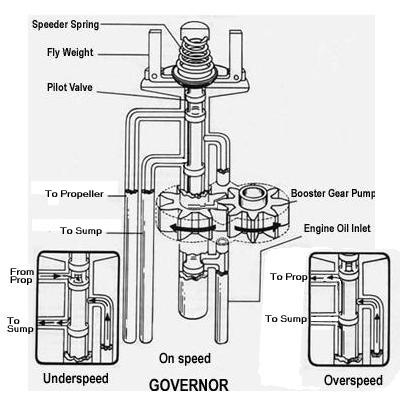What does "Constant speed propeller" mean?
It means a constant RPM (revolution per minute) system that permits the pilot to select the propeller -- and engine -- speed the pilot wants for any situation, and then automatically maintain that RPM under varying conditions of airspeed and power
.
How Is the RPM Controlled?
It is done by varying the pitch of the propeller blades. The pitch is the the angle of the blades with relation to the plane of rotation. As the blade angle is reduced, the torque required to spin the propeller is reduced and the airspeed and RPM of the engine will tend to increase for any given power setting.

Convesely, if the blade angle increases, the required torque increases. Then the engine and the propeller will tend to slow down.

Thus, we can control the RPM by varying the blade angle or pitch of the propeller.
Does It Mean That the Propeller Operates at the Same Speed All the Time?
No. The system allows the pilot to select the RPM he/she wants. The pilot has a control in the cockpit for this. When the pilot wants maximum power at low airspeed such as for takeoff, the pilot pushes this control full forward. This gives low pitch and maximum RPM with full throttle. This is great for getting off the ground, but it is normally not desirable for cruising at high airspeeds. So the pilot can ease back on the throttle and the propeller control for cruising. This increases the pitch and the speed settles into the desired RPM for cruise conditions. The RPM automatically stays set until the pilot moves the control.
How Is the Pitch of the Blades Changed?
It is changed hydraulically in a single acting system using engine oil from the propeller governor to increase the pitch of the propeller blades.
Oil pressure acting on the piston in the propeller produces a force that is opposed by the natural centrifugal twisting moment of the blades and a spring. This moves the piston back. Motion of the piston is transmitted to the blades through the actuating links and pins, moving the blades toward high pitch.
When the opposing forces are equal, oil flow to the propeller stops and the piston will also stop. The piston will remain in this position holding the pitch of the blades constant until oil flow to or from the propeller is established by the governor. Pitch is decreased by allowing oil to flow out of the propeller to be returned to the engine sump. When the governor initiates this procedure, hydraulic pressure is decreased and the piston moves forward, which moves the blades toward low pitch. The piston will continue to move forward until the opposing forces are again equal.
What Is "Manifold Pressure"?
Manifold Pressure is the pressure of the fuel/air mixture induced into the engine cylinders. Manifold pressure is measured downstream of the throttle valve. When the throttle is closed, air outside the engine (under higher atmospheric pressure) can't flow into the induction system, despite the vacuum on the engine side of the throttle valve.

When the throttle is fully open, the pressure downstream of the throttle valve approaches that of the atmosphere. In other words, the air is forced into the induction system at the maximum pressure the atmosphere is capable of pushing.

Consequently, manifold pressure gives an approximate measure of engine power.
What Is Governor?
The propeller governor is an RPM sensing device which operates by means of the centrifugal force working on flyweights. The governor responds to a change in system RPM by directing engine oil to or releasing engine oil from the propeller to change the blade angle and return the system RPM to the original value. The governor may be set up for a specific RPM by the cockpit propeller control.The propeller governor uses the same principle of Flyball Governor invented by James Watt in the 18th century! A look at the governor and total system will help to explain how it works.



The governor mounts on and is geared to the engine. This drives governor gear pump and the flyweight. The booster gear pump boosts engine oil pressure to provide quick and positive response by the propeller. The rotational speed of the flyweight varies directly with engine speed and controls the position of the pilot valve. Depending on its position, the pilot valve with direct oil flow to the propeller allow oil to flow back from the propeller, or forward to the propeller.
by Yoichi Hariguch
Tango Zulu
.